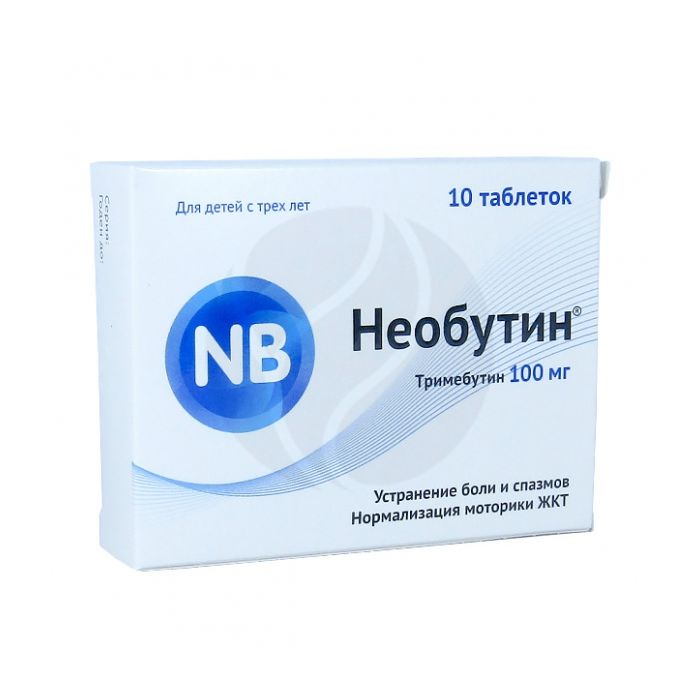Neobutin tablets 100mg, No. 10
Expiration Date: 11/2025
Russian Pharmacy name:
Необутин таблетки 100мг, №10
Adults and children from 3 years old.
Symptomatic treatment of pain, cramps and discomfort in the abdomen, bloating (flatulence), intestinal motor disorders with changes in stool frequency (diarrhea or constipation), dyspepsia, heartburn, belching, nausea, vomiting associated with functional diseases of the gastrointestinal tract and biliary tract (non-erosive form of gastroesophageal reflux disease;
cholelithiasis;
dysfunction of the biliary tract;
irritable bowel syndrome;
dysfunction of the sphincter of Oddi, postcholecystectomy syndrome).
Postoperative paralytic intestinal obstruction.
Inside, before meals.
Adults and children over 12 years old : 100-200 mg 3 times a day.
To prevent recurrence of irritable bowel syndrome after the course of treatment during the period of remission, it is recommended to continue taking the drug at a dose of 300 mg per day for 12 weeks.
Children aged 5-12 years : 50 mg 3 times a day.
Children aged 3-5 years : 25 mg 3 times a day.
1 tablet contains:
active substance: trimebutine maleate 100 mg
excipients : lactose monohydrate, corn starch, colloidal silicon dioxide (aerosil), magnesium stearate.
Hypersensitivity to trimebutin maleate and other components that make up the drug.
Children under 3 years of age (for this dosage form).
Pregnancy.
Lactose intolerance, lactase deficiency, glucose-galactose malabsorption.
Trade name of the drug:
NeobutinЃ
International non-proprietary name:
Trimebutin
Dosage form:
pills
Composition:
1 tablet contains:
active substance: trimebutine maleate 100 mg / 200 mg;
excipients : lactose monohydrate, corn starch, colloidal silicon dioxide (aerosil), magnesium stearate.
Description:
Dosage 100 mg:
Round flat-cylindrical tablets of white or almost white color with a beveled and cross-shaped line.
Dosage 200 mg:
White or off-white round biconvex tablets with scoring.
Pharmacotherapeutic group:
Antispasmodic
ATX code:
A03AA05
Pharmacological properties
Pharmacodynamics
Trimebutin, acting on the enkephalinergic system of the intestine, is a regulator of its peristalsis. Acting on peripheral? -,? - and k-receptors, including those located directly on smooth muscles throughout the gastrointestinal tract (GIT), it regulates motility without affecting the central nervous system. Thus, trimebutin restores the normal physiological activity of the intestinal musculature in various diseases of the gastrointestinal tract associated with motility disorders. By normalizing visceral sensitivity, trimebutin provides an analgesic effect in abdominal pain syndrome.
Pharmacokinetics
Absorption and distribution . After oral administration, trimebutin is rapidly absorbed from the gastrointestinal tract, the maximum plasma concentration (Cmax) is reached after 1-2 hours. Bioavailability is 4-6%.
The volume of distribution (Vd) is 88 liters. The degree of binding to plasma proteins is low - about 5%. Trimebutin slightly crosses the placental barrier.
Metabolism and excretion . Trimebutin is metabolized in the liver and excreted through the kidneys mainly in the form of metabolites (approximately 70% during the first 24 hours). The half-life (T?) Is about 12 hours.
Indications for use
Adults and children from 3 years old.
Symptomatic treatment of pain, cramps and discomfort in the abdomen, bloating (flatulence), intestinal motor disorders with changes in stool frequency (diarrhea or constipation), dyspepsia, heartburn, belching, nausea, vomiting associated with functional diseases of the gastrointestinal tract and biliary tract (non-erosive form of gastroesophageal reflux disease;
cholelithiasis;
dysfunction of the biliary tract;
irritable bowel syndrome;
dysfunction of the sphincter of Oddi, postcholecystectomy syndrome).
Postoperative paralytic intestinal obstruction.
Contraindications
Hypersensitivity to trimebutin maleate and other components that make up the drug.
Children under 3 years of age (for this dosage form).
Pregnancy.
Lactose intolerance, lactase deficiency, glucose-galactose malabsorption.
Application during pregnancy and during breastfeeding
Pregnancy. Experimental studies have not revealed data on teratogenicity and embryotoxicity of trimebutin. However, due to the lack of necessary clinical data, the use of trimebutin during pregnancy is contraindicated.
Breastfeeding period . It is not recommended to use trimebutin during breastfeeding, due to the lack of reliable clinical data confirming the safety of the drug during this period.
If necessary, the use of trimebutine during breastfeeding, breastfeeding should be discontinued.
Method of administration and dosage
Inside, before meals.
Adults and children over 12 years old : 100-200 mg 3 times a day.
To prevent recurrence of irritable bowel syndrome after the course of treatment during the period of remission, it is recommended to continue taking the drug at a dose of 300 mg per day for 12 weeks.
Children aged 5-12 years : 50 mg 3 times a day.
Children aged 3-5 years : 25 mg 3 times a day.
Side effect
From the digestive system: dry mouth, unpleasant taste, diarrhea, dyspepsia, nausea, constipation.
From the nervous system : drowsiness, fatigue, dizziness, headache, anxiety, feeling of heat or cold.
Allergic reactions: skin rash.
Others: menstrual irregularities, painful enlargement of the mammary glands, urinary retention.
Overdose
To date, no cases of trimebutine overdose have been reported.
Interaction with other medicinal products
The drug interaction of the drug NeobutinЃ is not described.
special instructions
The course of treatment of irritable bowel syndrome in the acute period at a dose of 600 mg per day for four weeks and the continuation of treatment after the course of the course at a dose of 300 mg per day for 12 weeks avoids the recurrence of the disease.
Influence on the ability to drive vehicles and mechanisms
The drug does not have a sedative effect, does not affect the speed of the psychomotor reaction and can be used in people of various professions, including those requiring increased attention and coordination of movements. However, given the possible side effects that can affect these abilities (dizziness and others), care should be taken when driving vehicles and engaging in other potentially hazardous activities.
Release form
Tablets 100 mg and 200 mg.
On 10,15, 20, 30 tablets in a blister strip packaging from a film of polyvinyl chloride and printed aluminum foil varnished.
1.2, 3 blisters, together with instructions for use, are placed in a cardboard box.
Storage conditions
At a temperature not higher than 25 ? C.
Keep out of the reach of children.
Shelf life
3 years.
Do not use after the expiration date printed on the package.
Vacation conditions
Available without a prescription.

